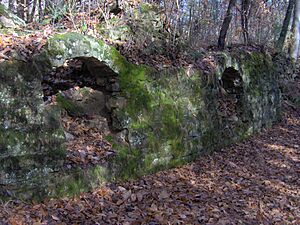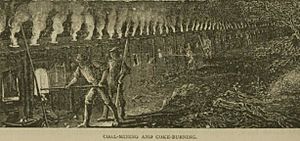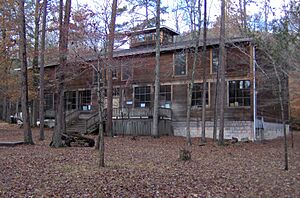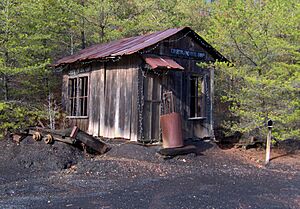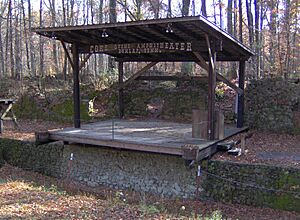Dunlap coke ovens facts for kids
Quick facts for kids |
|
|
Dunlap coke ovens
|
|
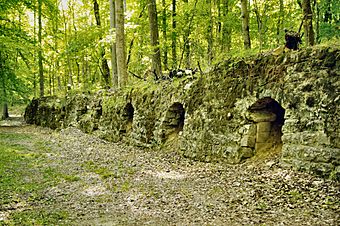 |
|
| Location | Hickory Street and Cordell Road in Dunlap, Tennessee |
|---|---|
| Area | 6 acres (2.4 ha) |
| Built | 1902, 1906, 1916 |
| NRHP reference No. | 85001489 |
| Added to NRHP | 1985 |
The Dunlap coke ovens are the old remains of a special factory near Dunlap, Tennessee, in the USA. This factory made a fuel called coke. People built these ovens in the early 1900s.
There were five groups of 268 ovens in total. They worked for different companies until the early 1920s. Today, these ovens are a historic site. The Sequatchie Valley Historical Society takes care of them as part of the Dunlap Coke Ovens Park.
During the time of the Industrial Revolution, the steel industry grew a lot. This meant people needed much more coke. Coke is a fuel made from heating coal. It was mainly used to make pig iron, which is a type of iron. The Dunlap coke factory turned coal from Fredonia Mountain into coke. This coke then went to big furnaces in nearby Chattanooga, Tennessee.
The factory brought many changes to Dunlap and the Sequatchie Valley. Before, people mostly farmed to feed themselves. The coke ovens brought new jobs and modern ways of life. Even though only the ovens are left, the Sequatchie Valley Historical Society has turned the area into a fun public park and museum.
Contents
Where are the Dunlap Coke Ovens?
The Sequatchie Valley is a long, narrow valley in the southern part of the Cumberland Plateau. Dunlap is the main town in Sequatchie County. It sits near the middle of this valley. The sides of the Plateau rise about 1,000 feet (300 m) above the valley floor. The Sequatchie River flows through the valley.
Fredonia Mountain is part of the western side of the valley. It rises steeply a few miles west of Dunlap. The Dunlap Coke Ovens are at the bottom of Fredonia Mountain. They are next to a stream called Coops Creek. You can find the ovens and the park on Mountain View Road, less than a mile west of downtown Dunlap.
How the Dunlap Ovens Made Coke
The Dunlap coke oven factory had five groups of ovens. Four groups were "double" batteries, meaning ovens were built back-to-back. One group was a "single" battery, built against a hill. Each group of ovens was about 9 feet (2.7 m) tall and 35 feet (11 m) wide. Their lengths varied from 180 feet (55 m) to 725 feet (221 m).
The biggest group had 100 ovens built back-to-back. The smallest had 24 ovens. The single group had 38 ovens and was 580 feet (180 m) long. All the oven groups sat on a base made of clay.
Each oven was about 12 feet (3.7 m) wide. They had sandstone on the outside and special firebricks on the inside. There was an opening at the top and a small "window" on the side. In the early 1900s, train tracks ran over the top of each oven group. A special railway carried coal from a mine higher up the mountain. Train cars would then dump the coal into the top openings of the ovens.
The Coking Process Explained
To make coke, a worker would use a tool to spread out the coal inside the oven through the side window. Once the coal was ready, the side window was sealed with clay. A tiny 1-inch (2.5 cm) opening was left for air.
This process involved heating bituminous coal in a closed space. This removed the gases and other materials from the coal. It usually took about 72 hours. When the process was done, the clay seal was broken. The finished coke was then taken out and loaded onto a train. It was shipped to iron factories in Chattanooga. Usually, two tons of coal would make one ton of coke.
History of the Dunlap Coke Ovens
When the railroad arrived in the 1880s, it brought big coal mining businesses to the southern Cumberland Plateau. People first mined coal on Fredonia Mountain in 1899. This coal was thought to be too soft for home use.
In 1900, the Douglas Coal and Coke Company bought a large area of land. They planned to mine coal and make coke there. By 1902, Douglas had built the first 50 coke ovens. They also opened several coal mines and built the special railway. The company even created a small town for its workers, with a store and a clubhouse. However, the company faced challenges with its workers and had trouble cleaning the dirt from the coal. In 1904, Douglas stopped working.
The Chattanooga Iron and Coal Company bought the Douglas operation in 1905. The next year, they built a steam-powered machine to wash coal. They also built more coke ovens. This company owned rock quarries in Georgia and a large furnace in Chattanooga. They used the coke from Dunlap to turn iron ore from Georgia into pig iron at their furnace.
This business was successful until 1916. That year, a boiler exploded and destroyed their coal washer. The company built a new washer and more ovens. But the new washer was expensive and didn't work well. This caused financial problems for the company. In 1919, they sold everything to the Southern States Iron and Coal Company.
By 1920, Dunlap was like two towns. The main town of Dunlap had about 765 people. The company town, where the ovens are now, had about 700 people. The company had 350 workers in Dunlap. The coke ovens needed a team of 85 people to run fully. Southern States Iron and Coal made coke in Dunlap until 1922, when they closed their operations. In 1928, two brothers bought the properties. They hoped to start the coke factory again. But the Great Depression happened, and coal prices dropped. Their plans never came true.
Dunlap Coke Ovens Park Today
After the 1920s, the Dunlap Coke Ovens were left alone for over 50 years. By the 1980s, only the ovens, a pile of waste rock, and the ruins of the coal washer remained. Some ovens had only their sandstone frames left. Others had only their brick insides. Some had completely fallen apart.
In 1985, the ovens were added to the National Register of Historic Places. The land was owned by the Bowater Corporation, which then gave it to the Sequatchie Valley Historical Association. Hundreds of volunteers helped clean up tons of trash from the area. The Dunlap Coke Ovens Park officially opened in 1987.
To get money for staff and upkeep, the Historical Association built an outdoor stage next to one of the oven groups. They held their first yearly Coke Ovens Bluegrass Festival. In 1989, the park received a large donation. They used this money to rebuild the company store on its original foundation. This rebuilt building is now the Coke Ovens Museum.
Besides the museum, ovens, and outdoor stage, the park has more to see. There's a copy of a coal mine with old mining machines. You can also see the ruins of the 1906 coal washer. There's a copy of the old Dunlap train station and a caboose. The park also has various shelters for visitors. A hiking trail now follows the path of the old railway up to the former mining areas on Fredonia Mountain.
Annual Bluegrass Festival
The park's most famous event is its yearly bluegrass festival. It happens on the first weekend of June. This event brings together bands and fans from all over the region. Many bluegrass musicians from Chattanooga also come. The festival shows the strong friendship between bluegrass music and the historical association. Local musicians helped a lot when the park was being built. They gave their time, connections, and entertainment to help with cleaning, building, and raising money. The event is known for being fun for the whole family.
Documentary Film
In 2008, a filmmaker named Charli Wyatt made a half-hour film about the park and the bluegrass festival. The film tells the story of the volunteers and musicians. They work hard to save local history and culture through the Coke Ovens park and festival. The film was shown several times on Chattanooga's PBS station, WTCI. A DVD was also sold locally. The film's title comes from a song written by Ed Brown, who is the festival's music director and an original member of the historical society.
Bluegrass Monument
In 2008, a group of local bluegrass fans put up a special monument. It honors the bluegrass musicians who have played at the park or in the Sequatchie Valley. The names of these musicians are carved into stone slabs on each side of the monument.


